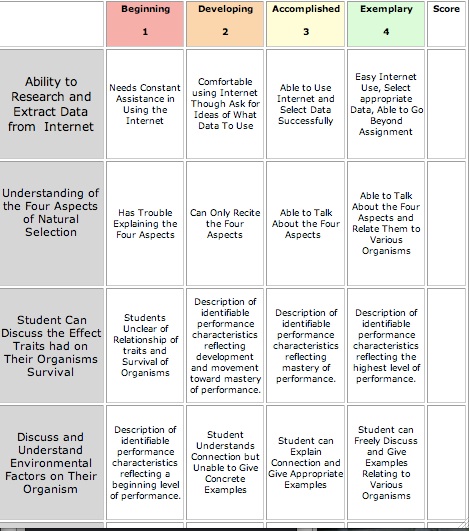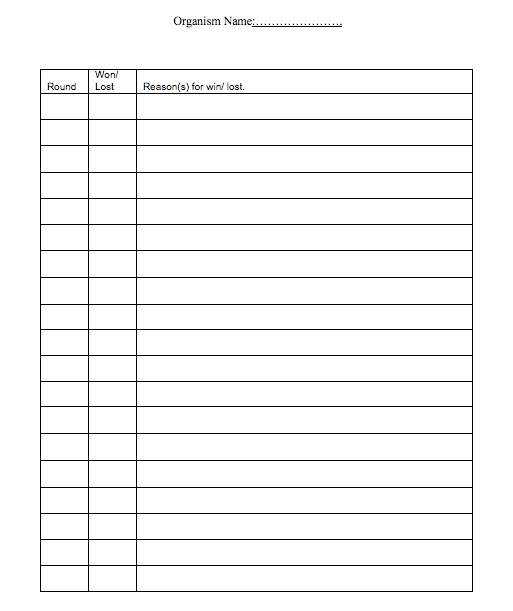Natural Selection Game
Students Page
A WebQuest on Natural Selection
Designed by Frank Hudson
Put some interesting graphic representing the content here
Introduction | Task | Process | Evaluation | Conclusion | Credits | Teacher Page
Introduction:
*Are you the predator or prey?
*Will you live long enough to pass your traits to your the next generation?
This game is designed to introduce and help demonstrate the fascinating world of natural selection. A student chooses an organism and is able to see their organism through evolutionary adaptations.
Each student will select an organism and research the different traits that organism has. Such as a gazelles agility, a tigers stealth, an octopuses camouflage, or a hawks sight. You will then compete to see which organism will survive to reproduce and which will perish.
The Task
Students will demonstrate their knowledge and understanding of Natural Selection.
1. Students will know who Darwin and Wallace are.
2. Students will describe the four aspects of Natural Selection.
3. Students will be able to discuss their thoughts on when Natural Selection helps an organism and when it does not.
4. Students will be able to explain and discuss if Natural Selection improves an organism’s chance for survival.
5. Students will be able to discuss the impact the environment (drought, floods, people, etc.) have on different organisms.
The Process
The first step is to choose an organism and research its traits and habitat. What is your organisms special abilities, how does it hunt or survive in its environment? Be prepared to tell why your organism did or didn't survive.
*Use your imagination and have fun*
Start:
*Cut out game templates. (Found at end of this site).
*Cut each strip into 5 separate,vertical rows.
*Divide class in groups of two.
*Each player rolls 2 dice; highest role picks first -predator or prey.
*Players may use pictures or miniatures to depict organism.
*Each player begins with 5 organisms that are assigned 1 trait each.
ie. Speed, sight, hearing, smell, camouflage, etc.
*Each strip of paper is placed face down in a straight row between players.
1. Each player picks one organism (strip of paper) from his or her opponent’s row.
2. Each player rolls 2 dice.
3. If one player rolls doubles than that player wins.
*And each player must describe circumstances that would cause an automatic win.
ie. Winner’s organism had stealth and was able to sneak up without being detected. Or loser’s organism fell and broke a leg or starved and perished. Then loser’s organism is removed from play. Continue from rule 1.
4. If no doubles are rolled. Than each player adds their total from their own dice and adds that to the number of traits of their selected organism.
ie. Die one =2, Die two = 3, one trait … total 2+3+1= 6.
5. Player with highest total wins that round.
6. Losing player removes that organism from play.
7. Each player keeps track of round and reasons each organism won or lost.
ie. Winner’s organism had stealth and was able to sneak up without being detected. Or loser’s organism fell and broke a leg.
8. If totals are equal then round is a draw. Reshuffle traits and reselect organisms.
*Restart from rule 1. Otherwise continue to rule 9.
9. Winner gains another organism with 1 trait. Successful breeding.
10. This ends the first round.
11. Each player selects one of their own organisms and writes one other trait to that organism (each player thinks of their own trait to add) then each player shuffles their organisms and places the card back, face down.
12. Repeat from step 1.
13. Game continues till one player loses all their organisms. Or players reach a previously set time limit.
Notes/ Suggestions:
-- Organisms cannot have two of the same traits.
-- Game ends after previously set time limit is reached or player with the most organisms wins. If both players are equal than game is a draw; or when one player loses all their organisms then opponent wins.
-- Divide students into teams of two. Winner of each team plays winner of another team. Continue till only one winner in class.
-- Game allows for predator vs. prey; predator vs. predator; prey vs. prey.
-- During play: players discuss why traits help organisms, why organism lost or won each round.
ie. Agility trait helps prey turn quickly while running; predator was unable to capture prey because it tripped.
-- Possible play… add 1 point for each organism above the original 5 organisms traveling in pack or herd bonus.
Evaluation
Students will be evaluated on their ability to research using the Internet. Their understanding of Natural Selection, and how well they can discuss whether their traits helped their organism. Also, the environmental factors relating to an organism's survival.

Conclusion
Students will demonstrate their knowledge and understanding of Natural Selection.
1. Students will know who Darwin and Wallace are.
2. Students will describe the four aspects of Natural Selection.
-
3.Students will be able to discuss their thoughts on when Natural Selection helps an organism and when it does not help an organism.
-
4.Students will understand the effect the environment has on different organisms.
The intent of tis game is to help students understand and be able to discuss Natural Selection. And to show students that all organisms rely on their special abilities to survive. Also, that an organism has a very important relationship with their environment.
Credits & References
I like to thank my Professor Barbara Shaw (PSU) for encouraging to develop this game. www.sciencea2z.com.
And a Thanks to Professor Mark Bailey (Pacific University) for teaching me how to put this Webpage together.
Game Template


Last updated on August 15, 1999. Based on a template from The WebQuest Page

